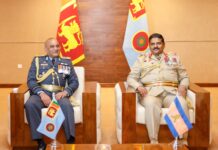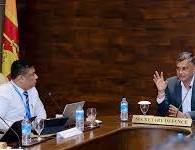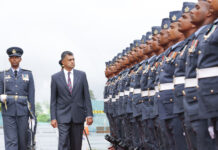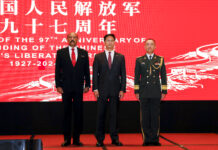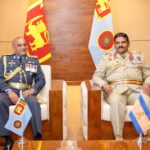Compiled by: Gp Capt Kumar Kirinde, SLAF (Retd)
Based on material and information provided by Roger Thiedeman, aviation historian, and Capt. Dhamseth Pallawela, aviator and aviation history enthusiast.
De Havilland Vampire T.55 and FB.52 (UK)
The first jet aircraft ordered for the Royal Ceylon Air Force were three de Havilland Vampire T.55 two-seat trainers, and two FB.52 fighter-bomber/attack variants. The order was placed in 1954, three years after foundation of the RCyAF in 1951.
The Vampire T.55s were shipped to the port of Colombo later that year. With RCyAF serials CF-501 to -503 already allocated, they arrived dismantled and packed in crates. But without even being unpacked, the three T.55s were loaded back on board a ship and returned to the UK. Concurrent with that decision, the remaining portion of the order, for the two FB.52s, was cancelled, so the latter aircraft (CF-510 & -511) never arrived in Ceylon.
The three Vampire T.55s were subsequently reallocated by the de Havilland Company to the Finnish Air Force. The fate of the two undelivered FB.52s is not known.
[For the record, when the decision to acquire Vampires was made, and the aircraft were subsequently sent back to the manufacturer, the UNP government led by Sir John Kotelawala was in power, with Air Commodore Graham Clarke Bladon serving as the first Commander of the RCyAF, on secondment from Britain’s Royal Air Force (RAF).]
Air Chief Marshal (retd.) Deshamanya Pathman ‘Paddy’ Mendis, the fourth Commander of the RCyAF/SLAF, expressed his view on the Vampire controversy in the book Wings of Sri Lanka: Sri Lanka Air Force, Fifty Years of Service to the Nation: 1951-2001, by Rienzi Pereira, as follows:
“When we returned from Cranwell, we found six [sic – should read ‘three’] Vampire Jets still in their crates, sitting in Katunayake. Having been trained on these aircraft in the UK with the RAF, we were looking forward to flying them operationally. But we were told that the Vampires were really on their way back to England! A lot has been written and spoken about in this regard, and the record must be set straight. It has been said, that the Commander of the time had thought the Vampires too advanced for Ceylonese pilots. This was nonsense! After all, we had been trained on them already! The truth of the matter is that, the requirements of the Air Force, and the defence policies of the nation had changed to a largely peacetime operation. Thus, there was really no role to be played by aircraft like the Vampire in the RCyAF of the day. De Havilland, the manufacturers, were not about to take them back and refund our money; so we had to order the Doves.”
The ‘bare’ facts of the RCyAF’s abortive Vampire ‘saga’ are set out by British aviation historian David Watkins in two versions of a book he wrote about the de Havilland Vampire in 1996 and 2013. The latter version contains updated and more definitive accounts, correcting some of the inaccurate and/or incomplete information that may have been available to the author when he published the earlier edition. For that reason, only the data supplied by Watkins in the 2013 book, as recounted above, should be regarded as the most up-to-date and factual.
Hunting Percival Jet Provost T51 (UK)
Commencing in 1959, the RCyAF received 12 Hunting Percival Jet Provost T51 aircraft, which became Sri Lanka’s first jet fighter/trainers. The order placed for the type was the first from an overseas air force, as mentioned in a press release issued in July 1959 by the manufacturer, Hunting Aircraft Ltd, England.
Apart from their use as advanced trainers (with two side-by-side seats), the RCyAF’s Jet Provosts were deployed in peace-keeping and deterrent roles. In January 1966, when a nationwide Emergency was declared because of political demonstrations and unrest of a communal nature, Jet Provosts were flown in a ‘show of strength’ over potential trouble spots. It was during this period, on January 17, that a Jet Provost was destroyed in an accidental fatal crash at Katunayake, as recounted and illustrated in a previous e-Doc.
Earlier, on February 1, 1960, a Jet Provost crashed into the Negombo Lagoon after then-Pilot Officer Noel Lokuge activated his ejector seat and bailed out safely following an engine flame-out during a formation-flight rehearsal. Accounts of this incident, both from Sqn Ldr Lokuge (retd.) himself and aviator/writer Ashi Fernando, have been distributed to the RAFOA readership by the compiler of this series of e-Docs.
During the 1971 JVP Insurgency, which commenced on April 5 that year, Jet Provosts fired their Browning guns and rockets ‘in anger’, becoming “effective weapon(s) against insurgent concentrations”, according to The History of the Sri Lanka Force Vol. 1 by Nalin Wijesekera & Vijitha Tennekoon.
Sadly, a third Jet Provost was lost in a second fatal crash, in the vicinity of Thampalakamam Bay, whilst en route to a bombing attack at Polonnaruwa less than a fortnight after the JVP Insurgency broke out. An eyewitness account of this accident, by Sqn Ldr Chira Fernando (retd.), has also been published in an e-Doc for RAFOA readers.
Mikoyan Gurevich MiG-17F Fresco* and MiG-15UTI Midget* (USSR)
Inducted in 1971 to counter the JVP-led insurrection which began in April that year were five MiG-17F fighters and a single MiG-15UTI two-seat advanced trainer, all from the USSR.
Two-seat trainer versions of the MiG-17 were never mass-produced, hence the need for the MiG-15UTI to train pilots to fly the two basically similar types.
Up to the time of their arrival in Ceylon, the MiG-17s were the only true combat aircraft operated by the RCyAF (which became the Sri Lanka Air Force in 1972).
The original batch of six MiGs were retired from service in 1979.
(*Fresco and Midget were NATO reporting (code) names for the MiG-17 and MiG-15UTI, respectively.)
Shenyang/Guizhou/Chengdu FT-5, FT-7 and F-7BS (China)
During the second half of 1991, a ‘mix’ of seven jet fighter and trainer aircraft were inducted for operations against the LTTE. All Chinese-built versions of Soviet MiG aircraft, the complement of fast jets comprised:
2 x Shenyang FT-5 two-seat trainers (based on the MiG-17IJ)
1 x Guizhou GAIGC FT-7 two-seat trainer (MiG-21US)
4 x Chengdu F-7BS fighter/ground attack aircraft (MiG-21F-13)
IAI Kfir C.2, TC.2 and C.7 (Israel)
The Chinese F-7 ground attack aircraft were incapable of carrying more than two 250kg bombs per mission. To overcome that deficiency, commencing in January 1996 the SLAF began inducting six IAI (Israel Aircraft Industries) Kfir C.2 single-seat fighter jets plus one Kfir TC.2 two-seat trainer variant of the same type. (‘Kfir’ is the Hebrew word for ‘lion cub’.)
Four more Kfir C.2s were acquired in August and November of 2000. They were followed in January 2001 by the first of four Kfir C.7s, a vastly modified variant of the C.2 with improved General Electric J79-GE-J1E engine, two more ordnance points below the air intakes, better avionics, and other enhancements.
On June 30, 2021, it was announced that Israel Aerospace Industries will upgrade five currently ‘mothballed’ SLAF Kfirs for a return to service to “near Block 60 standard” with new systems and sensors, under the terms of a US$50 million contract.
Mikoyan Gurevich MiG-27 Flogger and MiG-23UB Flogger (Russia)
Commencing in June 2000, six MiG-27 ground attack fighters, with variable-sweep wings, were acquired by the SLAF. A single MiG-23UB two-seat trainer followed in December that year. Both types shared the NATO reporting/code-name Flogger.
Hongdu K-8 Trainer (China)
In 2000, six Chinese-built Karakorum 8 advanced jet trainers (a.k.a. K-8; Hongdu JL-8; or Nanchang JL-8) were acquired to bolster the SLAF’s flying training capability.
Chengdu F-7GS ‘Thunderbolt’ (China)
The latest ‘fast jets’ acquired by the SLAF, in early 2008, were six examples of the Chengdu F-7GS, described as a “new generation of air superiority fighter equipped with air-to-air missiles … a heavily upgraded version of the Chinese J-7 (F-7) fighter with Head Up Display (HUD) and glass cockpit.” It is the most sophisticated jet aircraft to join the fighter-fleet of the SLAF.
Sources
The following publications were used as reference sources in the compilation of some of the material for this document:
- The History of the Sri Lanka Air Force Vol. 1 by Nalin Wijesekera & Vijitha Tennekoon
- The Sri Lanka Air Force: A Historical Retrospect – 1985-1997 (Vol. 2) by Jagath P. Senaratne
- Wings of Sri Lanka: Sri Lanka Air Force, Fifty Years of Service to the Nation: 1951-2001 by Rienzi Pereira
- Sri Lanka Air Force: 60th Anniversary Exhibition (Souvenir, ISBN: 978-955-0265-01-5)
- Various issues of the British magazines AirForces Monthly and AIR International




